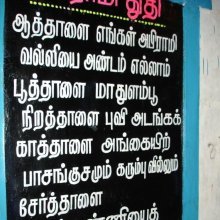Antam, Antām, Aṇṭam: 6 definitions
Introduction:
Antam means something in Hinduism, Sanskrit, biology, Tamil. If you want to know the exact meaning, history, etymology or English translation of this term then check out the descriptions on this page. Add your comment or reference to a book if you want to contribute to this summary article.
Antam has 4 English definitions available.
Images (photo gallery)
Languages of India and abroad
Sanskrit dictionary
[Deutsch Wörterbuch]
Source: Cologne Digital Sanskrit Dictionaries: Böhtlingk and Roth Grosses Petersburger WörterbuchĀntam (आन्तम्):—
Source: Cologne Digital Sanskrit Dictionaries: Sanskrit-Wörterbuch in kürzerer FassungĀntam (आन्तम्):—Adv. bis zum Ende ([Gautama's Dharmaśāstra 3,5]) vollständig , von Kopf bis zu Fuss.
Sanskrit, also spelled संस्कृतम् (saṃskṛtam), is an ancient language of India commonly seen as the grandmother of the Indo-European language family (even English!). Closely allied with Prakrit and Pali, Sanskrit is more exhaustive in both grammar and terms and has the most extensive collection of literature in the world, greatly surpassing its sister-languages Greek and Latin.
See also (Relevant definitions)
Starts with: Amtamula, Antama, Antamam, Antaman, Antamashas, Antamashato, Antamaso, Antamastha, Antamora, Antamoso, Antamukatu, Antamukha, Antamul.
Ends with (+502): A-piracittacampantam, Acakantam, Acamantam, Acampantam, Acapantam, Acarakantam, Accantam, Acuvakantam, Acuvantam, Adinantam, Adyupantam, Ajirnantam, Ajivitantam, Akalpantam, Akamantam, Akarnamtam, Akilantam, Akirantam, Akirunanantam, Akirunantam.
Full-text (+24): Munnantam, Yavadantam, Paryantam, Kallantam, Irantam, Pirukatpicam, Kutalantam, Anta, Kumuralantam, Sadyantam, Antat, Ticaiyantam, Cataiyantam, Tacaiyantam, Udantam, Antavanan, Rattavantam, Atyantam, Antanatu, Anuvedyantam.
Relevant text
Search found 20 books and stories containing Antam, Antām, Āntam, Aṇṭam, Andam, Antham; (plurals include: Antams, Antāms, Āntams, Aṇṭams, Andams, Anthams). You can also click to the full overview containing English textual excerpts. Below are direct links for the most relevant articles:
Shrimad Bhagavad-gita (by Narayana Gosvami)
Verses 16.11-12 < [Chapter 16 - Daivāsura-sampada-yoga]
Verse 8.17 < [Chapter 8 - Tāraka-brahma-yoga (the Yoga of Absolute Deliverance)]
Verse 11.16 < [Chapter 11 - Viśvarūpa-darśana-yoga (beholding the Lord’s Universal Form)]
Tiruvaymoli (Thiruvaimozhi): English translation (by S. Satyamurthi Ayyangar)
Pasuram 1.1.10 < [Section 1 - First Tiruvaymoli (Uyarvu ara Uyar Nalam)]
Pasuram 10.1.5 < [Section 1 - First Tiruvaymoli (Tala tamarai)]
Pasuram 7.4.1 < [Section 4 - Fourth Tiruvaymoli (Ali ela)]
Sahitya-kaumudi by Baladeva Vidyabhushana (by Gaurapada Dāsa)
Text 9.50 < [Chapter 9 - Ornaments of Sound]
Text 10.239 < [Chapter 10 - Ornaments of Meaning]
Text 10.123 < [Chapter 10 - Ornaments of Meaning]
Rig Veda (translation and commentary) (by H. H. Wilson)
Garga Samhita (English) (by Danavir Goswami)
Verse 4.12.16 < [Chapter 12 - The Story of the Gopīs That In the Holi Festival Displayed Three Transcendental Virtues]
Verse 5.18.7 < [Chapter 18 - Uddhava Hears the Gopīs’ Words and Returns to Mathurā]
Verse 1.17.36 < [Chapter 17 - Description of the Yogurt Theft]
Chandogya Upanishad (english Translation) (by Swami Lokeswarananda)
Verse 8.2.10 < [Section 8.2]
